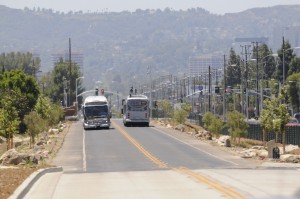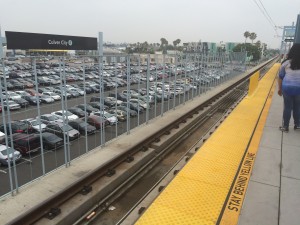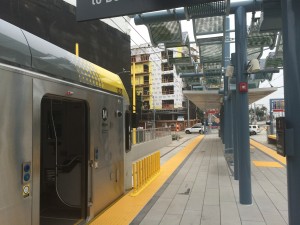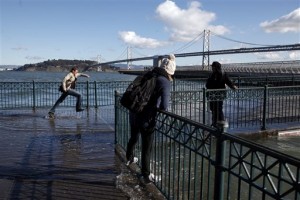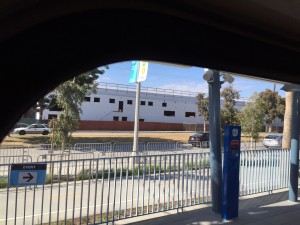In the run-up to this November’s big ballot initiative in Los Angeles County to raise revenue for transit through a higher sales tax, the pro-transit nonprofit Move LA argues that improved connectivity will boost ridership:
The new measure could deliver the necessary votes because it more than quadruples the connectivity of the rail system: Before Measure R riders could transfer from one line to another at 7 stations in the system, but the new measure would build projects that increase the number of transfer points to 32, enabling people to get from one corner of the county to any other corner. This is the secret sauce that will make ridership grow!
It’s a relatively minor quibble, but the real secret sauce to boosting ridership is to build more homes and offices within walking distance of the transit stations. Certainly more connectivity and faster service helps. But in the meantime, the region has plenty of transit stations that are operating now that could be leveraged to boost ridership.
And if the measure passes, it would be helpful if transit leaders could offer some guarantee that new spending on transit lines will be conditioned on this supportive land use development. Otherwise, the region will be replicating a pattern of under-performance that is still a major challenge for ridership in the existing system.
I’m honored to see that the on-line TransportiCA has launched a new book club contest with my book Railtown. The club will include a contest to win an autographed copy of the book. You just need to answer three questions on L.A. rail history correctly and submit it to the site. More details can be found here.
Check back in on the site for more details, and thanks to TransportiCA for the selection.
Count me in as a general well-wisher for bus rapid transit, or BRT. If done right, in dedicated lanes with multiple boarding openings and signal priority, it can mimic much of the benefits of rail (speed and reliability) at a fraction of the cost and time to build.
Many environmentalists and transit advocates agree, which is why more and more BRT lines are being introduced around the country, from Cleveland to San Francisco. Los Angeles has one of the first in the country in the San Fernando Valley (see the photo below — I document the history of the line in my book Railtown, as the one exception to my otherwise-exclusive focus on rail transit history).
But now Benjamin Ross, a transit advocate in Maryland, offers a surprising account of the history of bus rapid transit, with evidence that it originally sprang as an idea by the oil and gas industry and highway lobby to blunt momentum for rail transit.
While he acknowledges that buses are important and that BRT, when done right, can be successful, he ultimately believes that the push for BRT has in too many cases undercut momentum for much more effective rail transit systems. He also decries the “watered down” versions of BRT that lose many of the critical distinctions that make it a speedy and effective mode of moving people.
The account is hardly a paranoid polemic and seems well-balanced. For my part, I think context is everything. There is a reason that BRT has taken hold well beyond the anti-rail, pro-highway forces. Its low price tag, speed of construction, and quality of service are hard to beat and offer the perfect technology for certain corridors and mid-size neighborhoods. For places like Los Angeles, it would be easy to add bus-only lanes to existing highways, and that shouldn’t detract from the push for rail in high-density parts of the region.
But it’s worth considering Ross’s point that BRT advocacy can sometimes go too far and undercut the case for more right-sized transit like rail. His point about decision makers watering down BRT too much is also well taken — it’s not truly BRT without a dedicated lane and signal priority, at the very least.
Meanwhile, transit advocates should keep this mixed history in mind, in order to guard against efforts to divide them or to lower the quality of transit in the ongoing mobility battles in cities across the country and beyond.
The Los Angeles Times editorial board came out with a piece today that essentially supports L.A. Metro’s proposed new county sales tax measure [PDF] for transportation. While the writers discuss the controversy over having a “no sunset” tax (as opposed to the 2008 Measure R’s 30-year sunset), they acknowledge that “[w]hether Metro ultimately goes to the ballot with a 40-year, 50-year or permanent sales tax hike, the fact is Los Angeles County needs a great public transit system, and it’s going to take money to make it happen.”
But then in a striking admission, they issue a mea culpa of sorts for coming out against the region’s 1968 transit plan:
Nearly 50 years ago, Los Angeles County voters rejected a half-cent sales tax proposal that would have built an 89-mile rail and bus network between downtown, Long Beach, the San Fernando Valley and Westwood, the San Gabriel Valley, and even a route to LAX. The Times Editorial Board at that time urged a no vote, saying “we are an automotive people, unlikely to change our habits.” Imagine if voters had said yes? How many hours of congestion might have been avoided? How much pollution might have been prevented? Now, five decades later, our habits will have to change, one way or another.
I described that plan a bit in my book Railtown, as well as the subsequent sales tax failures in 1974 and 1976. The tragedy is that if any of those measures had succeeded, Los Angeles could have built the rail lines it has today much more cheaply and quickly.
Back in the late 1960s and early 1970s, the federal government was offering to pay 80 percent of the cost of new rail projects, with only a 20 percent state or local match required. It was a great deal that many cities took advantage of, but Los Angeles missed the window with all these electoral defeats. By the time local voters approved new rail lines in 1980, that federal offer dropped to 50 percent.
Meanwhile, it was cheaper and easier to build transit back in the 1970s, mainly because permitting was so much faster. Environmental reviews were minimal, and cities didn’t have the leverage back then to extract costly concessions from the county transit agency.
So given the rail lines that the region has today, how much it has spent on them, and how long it has taken to build them, voting down those measures in the 1960s and 1970s was definitely a fiscal and environmental mistake.
Kudos to the Times for recognizing that error.
Last week I finally got a chance to ride the new Expo Line extension to Santa Monica, and here are some takeaways:
-
Many stations have lots of free parking, with the sheriff’s office patrolling the lot I used in Culver City (see photo). This is a bit of a shock coming from the Bay Area, where BART parking costs money each day. So evidently demand is not that great, if Metro can afford to give this resource away for free. Ultimately this land would be better used as office and housing rather than expensive parking stalls for car drivers.
- Farmdale and the Westwood stops are basically pointless and should be closed down at least temporarily. Farmdale was created by a legal settlement solely to slow the trains down. Westwood is in a single-family residential neighborhood with what appears to be no hope for urban-style development. Any buses down Westwood (a heavily traveled boulevard) could intersect with Expo at a neighboring stop instead, like at Sepulveda.
- The Expo bike path didn’t seem to be heavily used. I rode the line both mid-day and during the afternoon commute time, but the adjacent new bike path was only used by the occasional jogger, as far as I can tell. I gather they’ll need to do a better job finishing the missing gaps in the bike lane, but in the meantime it seems like a huge opportunity for bike advocates to promote. Notably I saw a lot of people with bikes on the train — more than I’ve noticed on Bay Area trains.
- LA’s train culture and etiquette is still evolving. It’s a different thing to get used to traveling on a train with others instead of driving solo. At one point an elderly man with a walker tried to get on a jammed train, but nobody would scoot in towards the center of the car to let him on, despite another rider urging everyone to do so. “Sorry,” the rider told the man loudly as the doors closed. “Evidently this is a train full of A-holes.”
- But on the positive side, I saw a number of friendly interactions, such as the elderly couple sparking a conversation with a pregnant mom and two friends who happened to bump into each other on the train platform.
- The end-to-end travel time is worse than advertised. It took me 53 minutes to get from Santa Monica to downtown LA, worse than the estimated 46 minutes.
-
Lots of good development happening in downtown Santa Monica. I was pleased to see all the new apartment buildings going in right by the station (see photo). Those will be some lucky residents, being able to stroll down to the train from their homes and get east quickly.
Overall, despite some of these negative observations, it was pretty thrilling to ride the line. The views of neighborhoods I’d never seen before reminded me of how nice it can be to watch the world go by from an electric train, with a smooth ride and an opportunity to explore parts of the city you’d never see otherwise. And it was great to parallel Interstate 10 in parts while the freeway was badly congested.
So there’s a lot to be excited about with the new lines, but definitely a lot of room for improvement, too. It will be fun to watch the Expo Line, as a brand new, fully-built train route, settle in to the Westside.
The media coverage of the Expo Line to Santa Monica’s slow travel speed has been increasing. KPCC radio ran a segment describing the slow speeds and desire to give the trains signal priority in downtown Los Angeles.
Meanwhile, my proposal to have Metro consider shutting down under-performing stations generated some pushback. I’ll summarize the main arguments against here:
1) It’s too soon. The line just opened, and the stations may yet generate more ridership if we just wait a while.
My response: with something like ridership, it’s not just a matter of “getting the word out” or waiting for people to eventually figure out that the train is good for them. Ridership instead is a function of the land use around the stations and how densely packed the area is with jobs and housing. In the case of under-performing stations, the land use isn’t going to change right away. So while we wait for new developments, why continue serving the station if it slows the ride for everyone while providing relatively little benefit?
Bonus benefit: shutting the stations gives the locals an incentive to actually permit new construction. Right now, they have no incentive to do so and instead every incentive to cater to the usual “parking and traffic concerns” homeowner crowd.
2) It may hurt ridership overall to shutter the stations, and it’s supposed to be a “community” line — not a downtown-to-downtown line.
My response: I agree it may hurt ridership, which is why I suggest that Metro study the closures. If the relative improvement in travel times doesn’t produce enough new riders to cover the decrease in ridership from the closed stations, then it’s not worth pursuing. Case closed. But it may also require a temporary closure to get real-world data on ridership impacts.
And let’s not forget, downtown Los Angeles and downtown Santa Monica are major destinations that require speedy service between them.
3) Sheesh, the line just opened. Don’t jump to conclusions so quickly.
It may seem like a hasty conclusion, but the fact is that many of us foresaw this issue years ago. From my book Railtown (published 2014, but this passage was written in 2012):
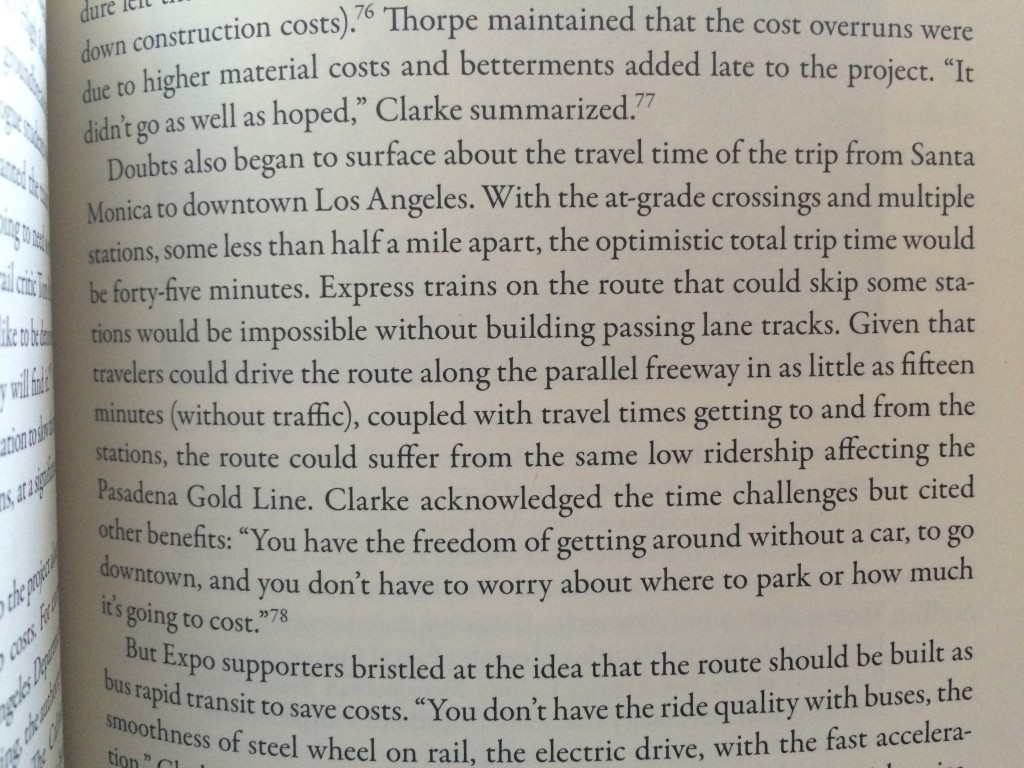 Furthermore, the Expo line was deliberately over-stationed precisely in order to slow the whole train. Again from Railtown:
Furthermore, the Expo line was deliberately over-stationed precisely in order to slow the whole train. Again from Railtown:
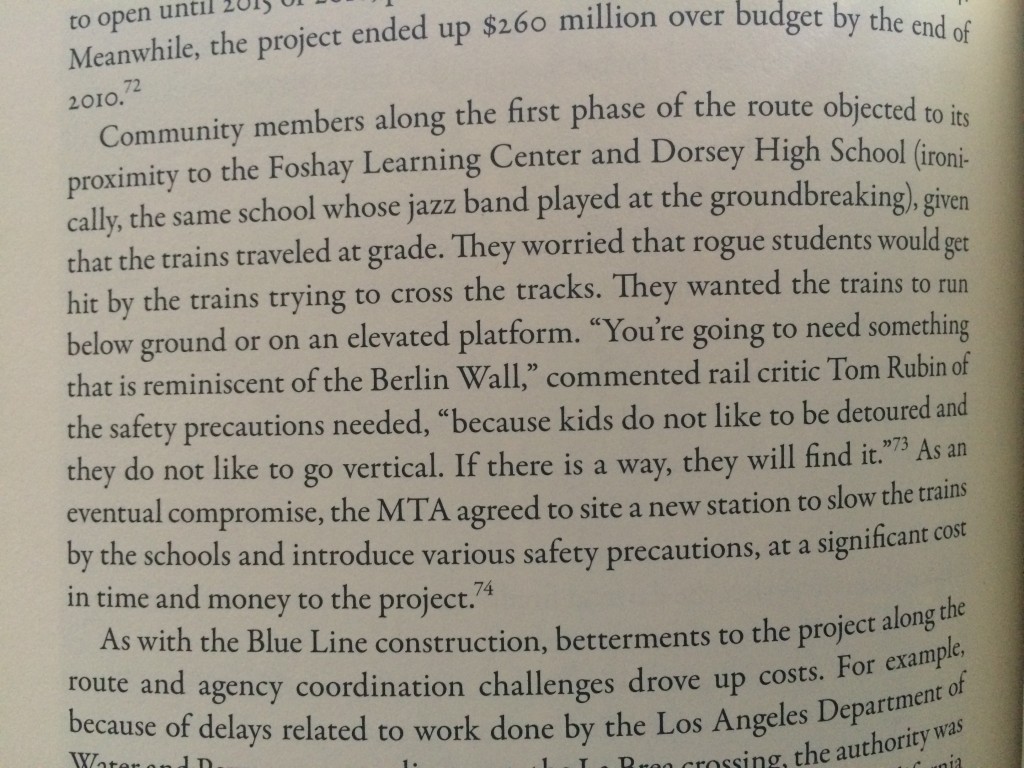 So I understand why some people thought this call was a hasty over-reaction. But the reality is that this issue has been brewing for a long time. And now that the public is finally riding the line, they’re experiencing the consequence of many poor decisions made over the years.
So I understand why some people thought this call was a hasty over-reaction. But the reality is that this issue has been brewing for a long time. And now that the public is finally riding the line, they’re experiencing the consequence of many poor decisions made over the years.
Perhaps overshadowed by the presidential primary, Tuesday’s California election saw a major win for a highly unique measure in the San Francisco Bay Area — one that could have big implications for regional approaches to solving environmental challenges like transportation and land use.
Measure AA was significant for two reasons: first, the $12 per parcel tax is likely the first in the nation to deal specifically with climate change impacts, as it dedicates the revenue, assessed across nine Bay Area counties, to help prepare for climate impacts and restoration on the San Francisco Bay. While much of the country pretends to ignore climate change science, Bay Area voters are actually setting aside money to prepare for it and protect the ecological and economic centerpiece of the region.
Second, and more importantly for other regions around the state, it’s the first time that multiple counties have gathered together with a two-thirds majority to raise money for a pressing environmental issue. Notably, the measure fell short of two-thirds support in some outlying counties, as the San Francisco Chronicle reports, but overcame that deficit with strong support in core Bay counties.
With this successful model, regional advocates may try the same approach for other metropolitan challenges that require multi-county coordination, such as transportation measures and land use policies. And maybe one day Los Angeles, Orange, and San Diego Counties will proposal a multi-county measure to link downtown Los Angeles, Anaheim and San Diego with high speed rail — the best corridor for the choo-choo in all of the state (and slated to be the last section built under current plans).
The possibilities are fairly wide open, limited only by organizing and political support. But Measure AA shows that the model can work.
Yesterday we had a fascinating discussion of the respective rail transit histories of San Jose and Los Angeles at SPUR San Jose, with a bunch of high speed rail tidbits thrown in.
It was a particular pleasure to hear from Rod Diridon, who is basically the father of rail transit in Santa Clara County, from the VTA light rail line to the under-construction high speed rail (slated to come to San Jose in the next decade or so).
Some takeaways from San Jose/Santa Clara County’s rail transit history:
- County leaders achieved a 56% voter approval on a local sales tax initiative to launch rail back in the 1970s, partly in response to a prominent New York Times article calling San Jose the worst planned city in the country, partly due to the highly educated technology workers coming to the area, and mostly due to strong leadership at the local, state and federal levels.
- The local measure required public review of the system development every four years, which in practice meant a ton of outreach to the public, which in turn resulted in widespread awareness of the system and much public buy-in. Part of this process involved colorful mailers sent to everyone in the millions, which also provided good advertising and elicited more political buy-in.
- Diridon noted the importance of steady local leadership. He, Congressman Norm Mineta, and State Senator Al Alquist occupied their positions at various levels of government in the area for decades, allowing each to take ownership of the transit system and ensure that projects were built on time and on budget.
We also touched on high speed rail. Diridon chaired the High Speed Rail Authority and is a big booster. He surprised me by saying that the first segment from San Jose to somewhere around Bakersfield will make money by turning the Valley into bedroom communities. My impression is that the daily fare (up to $80 in today’s dollars, roundtrip) will be cost-prohibitive for most people living in the Valley.
In response to a question about getting rail from Union Station in Los Angeles to Palmdale, Diridon admitted that the route to Palmdale, which will add 15 minutes to the total ride, was made only because L.A. leaders like Supervisor Antonovich and Mayor Villaraigosa insisted the train stop there. Otherwise, he said, they wouldn’t have gotten the train built. It’s further evidence of the sad political compromise on the route.
In an irony though, he said the recent decision to change the route to now serve San Jose first is because of that Palmdale stop. Horse ranchers along the path from Palmdale to Burbank/San Fernando don’t want the train coming through, so they’ve created enough hassle to make the High Speed Rail Authority hold off on the Southern California section for now.
All in all, lots to learn in comparing the rail journeys of the two cities, which will one day be linked by high speed rail.
San Jose and Los Angeles are similar urban areas, despite their population differences. Both are primarily auto-oriented (with San Jose sometimes derisively referred to as “L.A. without the beach”). And both have recently sought to transform themselves into rail-oriented cities in recent decades.
Today at land use think tank SPUR in San Jose, the Honorable Rod Diridon and I will trace the history of the two cities’ urban transformation at a lunchtime talk. Mr. Diridon has a long and distinguished career in urban transportation issues in the South Bay, with a Caltrain/light rail transit station named after him just outside of downtown (we graded the surrounding neighborhood a “B” in our Next 10/Berkeley Law October report grading station neighborhoods across California).
The event is free and begins at 12:30. More information can be found here. I hope you can join.
As I feared, the travel time from downtown Los Angeles to downtown Santa Monica on the newly opened Expo rail line is worse-than-advertised, and the media is starting to notice. Joe Mathews has a very fair (and fairly depressing) account of his four-hour-plus commute from Pasadena to Santa Monica, worse than his typical three-hour commute by car:
The switch to the new Expo Line at the Metro Center station for the third leg of my trip was smooth. But the Expo Line was painfully slow. Metro had advertised a 48-minute ride, but it took more than an hour. The track runs down the middle of streets—and the train stops for traffic lights at some intersections. In Santa Monica, after a six-block walk, I arrived at work two and a half hours after I had reached the Pasadena station—25 miles away. In that same time, I could have flown to Las Vegas, played the airport slots, and flown home, jackpot in hand.
To be sure, the opening of the regional connector through downtown will certainly shave off travel time for riders like Joe. And if the City of Los Angeles can change the signal priority and street configuration, the trains will run a bit faster through downtown.
But otherwise, we’re left with a slow line, absent further infrastructure improvements like extra tracks to run express trains that can skip slow trains or more grade separation, like bridges over intersections. But those improvements cost money the region doesn’t have and won’t spend even if they had it, given how much Expo already cost to build and competing transit needs across the county.
So what’s the solution? The cheapest one is to shut down under-performing stations along the line. For anyone who’s ridden the line, it’s obvious there are some station areas that are low-rise and therefore low-ridership. Absent further development around them, Metro should shut them down and speed the ride for the majority of riders.
On the new extension, here are the initial ridership figures from one of the first days in service:
Palms: 1,016 TAP entries.
Westwood/Rancho Park: 661 TAP entries.
Expo/Sepulveda: 1,150 TAP entries.
Expo/Bundy: 1,376 TAP entries.
26th St/Bergamot: 853 TAP entries.
17th St/SMC: 1,020 TAP entries.
Downtown Santa Monica: 5,982 TAP entries.
If these trends continue, Metro should consider shutting down Westwood/Rancho Park and 26th Street/Bergamot on the new extension. (There would be particular irony in shutting down the 26th Street station, as local NIMBYs and their representatives on the city council prevented that station from becoming a thriving transit hub and instead relegated development to a suburban-style office park — see photo on the right of the building under construction).
Meanwhile, ridership data on the first phase of the extension to Culver City should inform which stations are shut down there. (Notably, one station on that phase was required as part of a legal settlement, which could complicate a shutdown effort for at least that station.)
The Expo Line runs 15.2 miles, and it shouldn’t take an hour. 15 miles per hour just isn’t providing much benefit over driving, if any. And it won’t make the line sustainable in the long run. So that’s why policy makers need to consider immediate action to improve the travel times.

